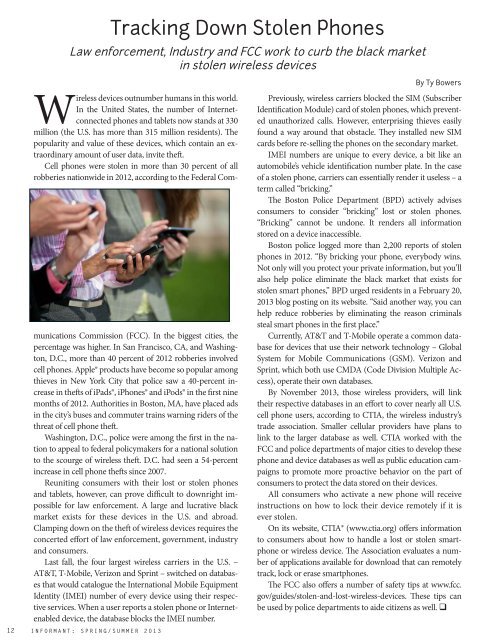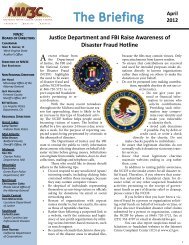Informant Vol 10 No 2 - 2013 Spring - National White Collar Crime ...
Informant Vol 10 No 2 - 2013 Spring - National White Collar Crime ...
Informant Vol 10 No 2 - 2013 Spring - National White Collar Crime ...
You also want an ePaper? Increase the reach of your titles
YUMPU automatically turns print PDFs into web optimized ePapers that Google loves.
Tracking Down Stolen PhonesLaw enforcement, Industry and FCC work to curb the black marketin stolen wireless devices12Wireless devices outnumber humans in this world.In the United States, the number of Internetconnectedphones and tablets now stands at 330million (the U.S. has more than 315 million residents). Thepopularity and value of these devices, which contain an extraordinaryamount of user data, invite theft.Cell phones were stolen in more than 30 percent of allrobberies nationwide in 2012, according to the Federal CommunicationsCommission (FCC). In the biggest cities, thepercentage was higher. In San Francisco, CA, and Washington,D.C., more than 40 percent of 2012 robberies involvedcell phones. Apple® products have become so popular amongthieves in New York City that police saw a 40-percent increasein thefts of iPads®, iPhones® and iPods® in the first ninemonths of 2012. Authorities in Boston, MA, have placed adsin the city’s buses and commuter trains warning riders of thethreat of cell phone theft.Washington, D.C., police were among the first in the nationto appeal to federal policymakers for a national solutionto the scourge of wireless theft. D.C. had seen a 54-percentincrease in cell phone thefts since 2007.Reuniting consumers with their lost or stolen phonesand tablets, however, can prove difficult to downright impossiblefor law enforcement. A large and lucrative blackmarket exists for these devices in the U.S. and abroad.Clamping down on the theft of wireless devices requires theconcerted effort of law enforcement, government, industryand consumers.Last fall, the four largest wireless carriers in the U.S. –AT&T, T-Mobile, Verizon and Sprint – switched on databasesthat would catalogue the International Mobile EquipmentIdentity (IMEI) number of every device using their respectiveservices. When a user reports a stolen phone or Internetenableddevice, the database blocks the IMEI number.INFORMANT: SPRING/SUMMER <strong>2013</strong>By Ty BowersPreviously, wireless carriers blocked the SIM (SubscriberIdentification Module) card of stolen phones, which preventedunauthorized calls. However, enterprising thieves easilyfound a way around that obstacle. They installed new SIMcards before re-selling the phones on the secondary market.IMEI numbers are unique to every device, a bit like anautomobile’s vehicle identification number plate. In the caseof a stolen phone, carriers can essentially render it useless – aterm called “bricking.”The Boston Police Department (BPD) actively advisesconsumers to consider “bricking” lost or stolen phones.“Bricking” cannot be undone. It renders all informationstored on a device inaccessible.Boston police logged more than 2,200 reports of stolenphones in 2012. “By bricking your phone, everybody wins.<strong>No</strong>t only will you protect your private information, but you’llalso help police eliminate the black market that exists forstolen smart phones,” BPD urged residents in a February 20,<strong>2013</strong> blog posting on its website. “Said another way, you canhelp reduce robberies by eliminating the reason criminalssteal smart phones in the first place.”Currently, AT&T and T-Mobile operate a common databasefor devices that use their network technology – GlobalSystem for Mobile Communications (GSM). Verizon andSprint, which both use CMDA (Code Division Multiple Access),operate their own databases.By <strong>No</strong>vember <strong>2013</strong>, those wireless providers, will linktheir respective databases in an effort to cover nearly all U.S.cell phone users, according to CTIA, the wireless industry’strade association. Smaller cellular providers have plans tolink to the larger database as well. CTIA worked with theFCC and police departments of major cities to develop thesephone and device databases as well as public education campaignsto promote more proactive behavior on the part ofconsumers to protect the data stored on their devices.All consumers who activate a new phone will receiveinstructions on how to lock their device remotely if it isever stolen.On its website, CTIA® (www.ctia.org) offers informationto consumers about how to handle a lost or stolen smartphoneor wireless device. The Association evaluates a numberof applications available for download that can remotelytrack, lock or erase smartphones.The FCC also offers a number of safety tips at www.fcc.gov/guides/stolen-and-lost-wireless-devices. These tips canbe used by police departments to aide citizens as well.
















